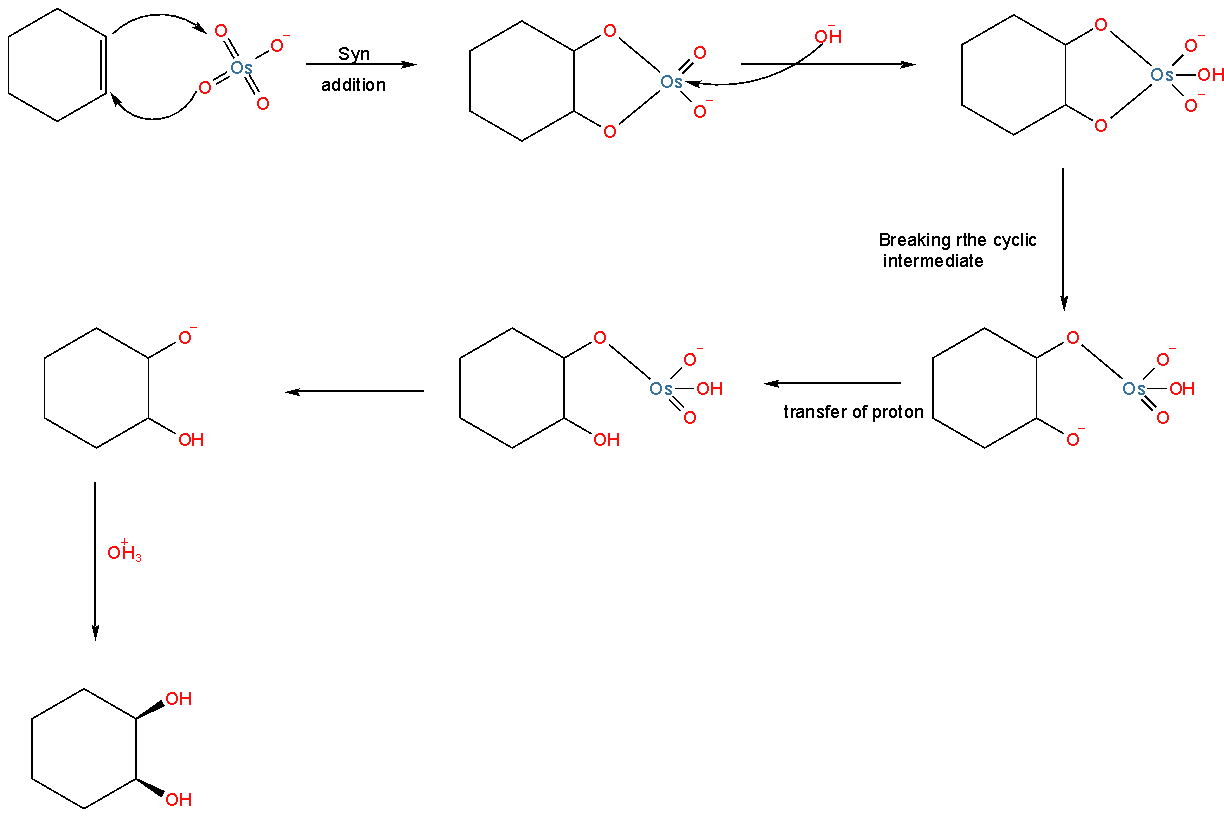
Cyclohexene on reaction with OsO4 followed by reaction with NaHSO3 gives
A. Cis-diol
B. Trans-diol
C. Epoxy
D. Alcohol
Answer
221.4k+ views
Hint: The process of conversion of alkene into vicinal diol is called dihydroxylation. It is an oxidation process and for this process, a transition metal with a high oxidation state is needed like osmium or manganese. OsO4 is the most important oxidising agent which is used for the process of dihydroxylation.
Complete Step by Step Answer:
The reaction of cyclohexane with OsO4 is a dihydroxylation reaction, dihydroxylation means the addition of two hydroxyl groups in the substituent, and the formation of vicinal diol takes place.
The reaction of Cyclohexene with OsO4 followed by a reaction with NaHSO3 will give a diol-
$C_6H_{10}\xrightarrow[]{OsO_4/NaHSO_3}C_6H_{10}\left ( OH \right )_2$

This is an oxidative addition reaction. And the mechanism of the reaction passes through the transition state and the formation of the transition state requires syn addition thus the product formed will be syn.
The reaction mechanism is

This process follows no rearrangement. The reaction follows syn addition, that is the addition of a new bond will be at the same face of the reactant. In this reaction, NaHSO3 is used to break the five-membered cyclic transition state.
Thus we can see that the Cyclohexene on reaction with OsO4 followed by reaction with NaHSO3 gives cyclohexane cis diol.
Thus, Option (A) is correct
Note: Bayer’s reagent which is alkaline potassium permanganate (alkaline) KMnO4 is also a strong oxidising agent which is also used for the formation of vicinal diol. Manganese also has a high oxidation state. It is also used for the determination of unsaturation in a compound.
Complete Step by Step Answer:
The reaction of cyclohexane with OsO4 is a dihydroxylation reaction, dihydroxylation means the addition of two hydroxyl groups in the substituent, and the formation of vicinal diol takes place.
The reaction of Cyclohexene with OsO4 followed by a reaction with NaHSO3 will give a diol-
$C_6H_{10}\xrightarrow[]{OsO_4/NaHSO_3}C_6H_{10}\left ( OH \right )_2$

This is an oxidative addition reaction. And the mechanism of the reaction passes through the transition state and the formation of the transition state requires syn addition thus the product formed will be syn.
The reaction mechanism is

This process follows no rearrangement. The reaction follows syn addition, that is the addition of a new bond will be at the same face of the reactant. In this reaction, NaHSO3 is used to break the five-membered cyclic transition state.
Thus we can see that the Cyclohexene on reaction with OsO4 followed by reaction with NaHSO3 gives cyclohexane cis diol.
Thus, Option (A) is correct
Note: Bayer’s reagent which is alkaline potassium permanganate (alkaline) KMnO4 is also a strong oxidising agent which is also used for the formation of vicinal diol. Manganese also has a high oxidation state. It is also used for the determination of unsaturation in a compound.
Recently Updated Pages
The hybridization and shape of NH2 ion are a sp2 and class 11 chemistry JEE_Main

What is the pH of 001 M solution of HCl a 1 b 10 c class 11 chemistry JEE_Main

Aromatization of nhexane gives A Benzene B Toluene class 11 chemistry JEE_Main

Show how you will synthesise i 1Phenylethanol from class 11 chemistry JEE_Main

The enolic form of acetone contains a 10sigma bonds class 11 chemistry JEE_Main

Which of the following Compounds does not exhibit tautomerism class 11 chemistry JEE_Main

Trending doubts
JEE Main 2026: Application Form Open, Exam Dates, Syllabus, Eligibility & Question Papers

Derivation of Equation of Trajectory Explained for Students

Hybridisation in Chemistry – Concept, Types & Applications

Understanding the Angle of Deviation in a Prism

How to Convert a Galvanometer into an Ammeter or Voltmeter

Degree of Dissociation: Meaning, Formula, Calculation & Uses

Other Pages
NCERT Solutions For Class 11 Chemistry Chapter 7 Redox Reaction

JEE Advanced Marks vs Ranks 2025: Understanding Category-wise Qualifying Marks and Previous Year Cut-offs

Hydrocarbons Class 11 Chemistry Chapter 9 CBSE Notes - 2025-26

Thermodynamics Class 11 Chemistry Chapter 5 CBSE Notes - 2025-26

NCERT Solutions ForClass 11 Chemistry Chapter Chapter 5 Thermodynamics

Equilibrium Class 11 Chemistry Chapter 6 CBSE Notes - 2025-26




